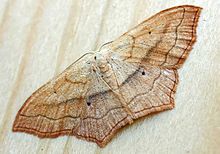Scopulini
Appearance
| Scopulini | |
|---|---|

| |
| Scopula imitaria | |
| Scientific classification | |
| Domain: | Eukaryota |
| Kingdom: | Animalia |
| Phylum: | Arthropoda |
| Class: | Insecta |
| Order: | Lepidoptera |
| Family: | Geometridae |
| Subfamily: | Sterrhinae |
| Tribe: | Scopulini Duponchel, 1845 |
| Synonyms | |
| |
Scopulini is a tribe of the geometer moth family (Geometridae), with about 900 species in seven genera. The tribe was described by Philogène Auguste Joseph Duponchel in 1845.
Systematics
[edit]Scopulini as a family name is an old synonym of the subfamily Sterrhinae (Meyrick, 1892). The tribe Scopulini is divided into seven genera, of which only Scopula and Problepsis have species in Europe.
- Scopulini Duponchel, 1845
- Dithalama Meyrick, 1888 (4 species in Australia and Tasmania)
- Isoplenodia Prout, 1932 (4 species in Africa)
- Lipomelia Warren, 1893 (1 species from India to Taiwan)
- Somatina Guenée, 1858 (44 species in Africa, East Asia and Australia)
- Zythos D. S. Fletcher, 1979 (11 species from Indonesia up to Papua-New Guinea)
- Problepsis Lederer, 1853 (51 species in the Palearctic, Africa, South-East Asia to Australia)
- Scopula Schrank, 1802 (including Glossotrophia Prout, 1913 and Holarctias Prout, 1913) (over 800 species)
Phylogenetics
[edit]The phylogenetics of Scopulini was described in detail in 2005 by Pasi Sihvonen.
| Sterrhinae |
| ||||||||||||||||||||||||
Literature
[edit]- Hausmann, Axel The Geometrid Moths of Europe, 2. Sterrhinae. Apollo Books, Stenstrup 2004, ISBN 87-88757-37-4
- Abraham, D.; Ryrholm, N.; Wittzell, H.; Holloway, J. D.; Scoble, M. J.; Lofstedt, C.: "Molecular phylogeny of the subfamilies in Geometridae (Geometroidea: Lepidoptera)". Molecular Phylogenetics and Evolution. 20(1): 65-77 (2001)
- Sihvonen, Pasi (April 1, 2005). "Phylogeny and classification of the Scopulini moths (Lepidoptera: Geometridae, Sterrhinae)". Zoological Journal of the Linnean Society. 143 (4): 473–530. doi:10.1111/j.1096-3642.2005.00153.x.
External links
[edit]- Lepiforum e.V.
- Moths and Butterflies of Europe and North Africa
- Savela, Markku. "Tribe Scopulini". Lepidoptera and Some Other Life Forms. Retrieved May 31, 2019.
- Fauna Europaea
